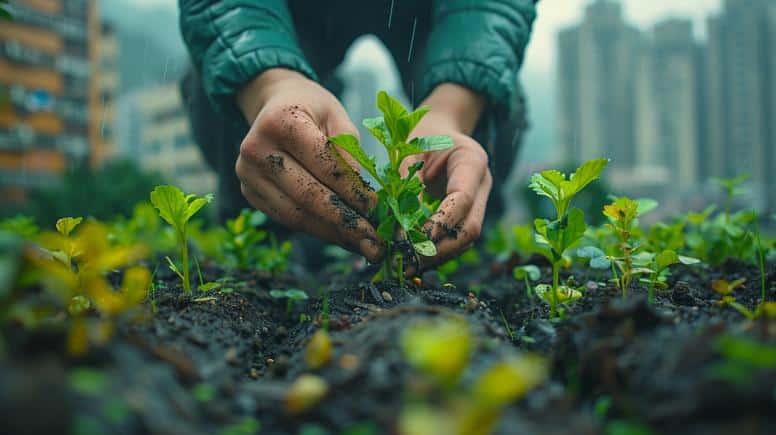Have you ever found yourself dreaming of a green oasis right in the heart of the city? With the “Urban Gardening: Guide for Beginners” guide, we will explore together the fascinating world of creating green spaces amidst the stone jungle. How to start an urban garden? Which plants to choose? Whether on a small balcony or a spacious terrace, this article is the first step to transforming your home into a natural haven of peace and beauty. Get ready to get your hands on the land and revolutionize your concept of “home” in the middle of the metropolis!
Where to start creating an urban garden?
When wondering how to start an urban garden, the first step is to assess the space available. In urban environments, these are often small and even vertical areas. Therefore, it is possible to optimize these spaces with some intelligent techniques such as vertical gardening or the use of hanging pots. This not only maximizes the use of space, but can also add a decorative element to the room.
When considering the selection of plants for an urban garden, it is essential to choose species that adapt well to the local climate and lighting conditions of the space. For example, plants that require full sun may not be the best choice for a balcony that only receives indirect light. Research more about plants suitable for each type of climate and lighting.
The first steps in urban gardening also involve preparing yourself with essential materials and tools. Items such as good soil, natural fertilizers, shovels, watering cans and containers are essential. Initiatives such as home composting can enrich the soil and reduce waste. And while challenges like space and soil contamination may seem daunting, with planning and creativity, gardening for beginners in the city can be an extremely rewarding and invigorating journey.
What are the best designs and techniques for gardens in small spaces?
Urban gardening offers inventive solutions for creating green spaces in environments with area limitations. Among the most effective techniques, gardening on balconies It is vertical gardens They are highly recommended due to their advantages in optimizing small spaces.
A vertical gardening is a technique that involves maximizing vertical space through the installation of structures such as plant walls or cultivation towers. This not only saves horizontal space, but also brings aesthetic and thermal comfort benefits to urban buildings.
About the use of containers and vases, they provide great flexibility, allowing changes in the arrangement of plants as needed and facilitating cultivation in areas such as balconies and terraces. Vases and containers also contribute to the aesthetics of the environment, opening up space for creativity in choosing colors, shapes and sizes.
More innovative techniques like hydroponics It is aquaponics are becoming popular in urban environments. These practices do not require the use of land, using nutritional solutions for plant growth, which can be particularly advantageous in urban areas where quality soil is a scarce resource.
To deepen your knowledge and be inspired by different plants for your urban gardening project, discover “Green in the City: Exploring Plant Varieties for Urban Gardens”, a valuable resource for every aspiring urban gardener.
Prioritizing these cultivation techniques can significantly transform small spaces into green oases, promoting not only beauty and biodiversity, but also well-being amid the concrete of cities.
How to maintain a healthy and productive urban garden?
To ensure the health and productivity of an urban garden, it is crucial to adopt efficient irrigation systems, proper composting practices, and natural pest control strategies. Each of these elements contributes to a balanced and sustainable gardening ecosystem, even in small spaces.
Efficient irrigation systems: how to save water and ensure adequate hydration
Irrigation systems for small spaces must optimize the use of water and provide the exact amount needed by the plants. A drip irrigation It is a highly efficient option, as it minimizes waste and supplies water directly to the roots, promoting more effective absorption.
Composting in the city: reducing waste and nourishing your garden
Composting in urban environments transforms organic waste into rich fertilizer, which serves as an excellent source of nutrients for plants. In addition to reducing the amount of waste sent to landfills, composting improves the soil structure of urban gardens, increasing its fertility and water retention capacity.
Natural Pest Control: Strategies for Maintaining a Balanced Garden
For pest control in urban gardens, a natural approach is best. Including plants that naturally repel harmful insects or that attract predators of those pests can help maintain balance without the need for chemicals. Techniques such as crop rotation and growing a diversity of species also contribute to a more resilient garden.
By adopting these practices, urban gardeners not only optimize their resources and efforts, but also promote a healthier and more productive environment for growing plants in the city.
What are the social and environmental impacts of urban gardens?
Urban gardens promote a significant improvement in air quality and an increase in biodiversity. These green spaces become home to a variety of plants and animals, contributing to a richer and more diverse urban ecosystem. Furthermore, they help to mitigate the heat island effect, a direct consequence of urbanization.
Urban green spaces are also essential for the mental health of city residents. Contact with nature has a proven calming effect that can reduce stress and increase overall well-being. Community gardening, in particular, strengthens social relationships and promotes a sense of community and belonging.
In the practice of community gardening, in addition to sharing responsibilities and resources, the act of caring for plants together can be a powerful tool for environmental and social education. This provides a platform to teach and learn valuable skills, from farming practices to sustainability itself.
Many initiatives urban gardening include sustainable practices such as composting, rainwater harvesting and organic pest control, which not only benefit the community's immediate environment but also serve as a model of sustainable behavior for the rest of the city.
Not only do these spaces provide visual relief from the concrete urban landscape, they also have a tangible impact on improving the quality of life in urban centers by supplying the community with fresh food and reducing the distance food travels from producer to consumer.
While the benefits are clear, the difficulties in implementing and maintaining such spaces cannot be ignored. However, when successful, urban gardens represent not just a green oasis amid the fast pace of city life, but a powerful force for sustainable progress and social cohesion.
In this article, we explore the initial steps to creating your own urban garden, from evaluating spaces to choosing the plants best suited to the city environment. We also unveil innovative methods to maximize small areas and techniques that favor aesthetics and efficiency. We emphasize the importance of maintenance, with smart irrigation systems, composting and organic pest control. Finally, we reflect on the significant impacts that urban gardens have on social and environmental well-being. It is hoped that this information will inspire and equip urban gardeners, both novice and experienced, to create green spaces that benefit not only themselves, but also their communities and the environment around them.
Frequently Asked Questions (FAQ)
1. How can I start creating an urban garden in limited spaces?
To start an urban garden in limited spaces, start by evaluating the space available and considering techniques such as vertical gardening and hanging pots to optimize the use of space.
2. What are the most effective techniques for urban gardens on balconies and terraces?
The most effective techniques for urban gardens in small areas include vertical gardening, using containers and pots, and innovative methods such as hydroponics and aquaponics.
3. What practices are essential to maintaining a healthy urban garden?
To maintain the health and productivity of an urban garden, it is essential to adopt efficient irrigation systems, proper composting practices, and natural pest control strategies.
4. What are the benefits of urban gardens for communities and the environment?
Urban gardens improve air quality, increase biodiversity, mitigate the heat island effect, contribute to the mental well-being of residents and promote environmental education and social cohesion.
5. How can urban gardening impact the sustainability of cities?
Urban gardening can promote sustainable practices such as composting and rainwater collection, serving as a model for the community and improving the quality of life in urban centers, in addition to providing fresh food.





